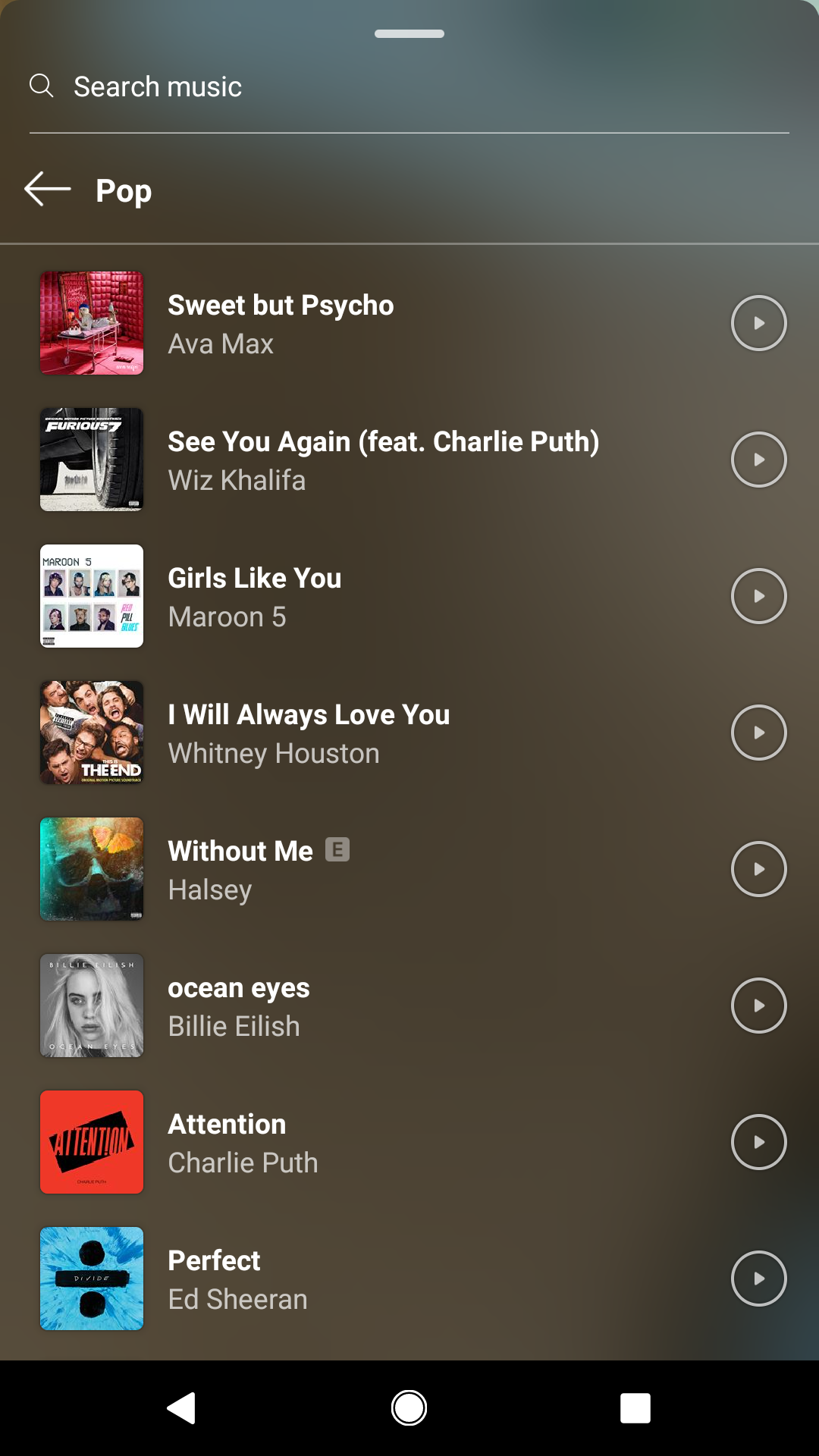Does Uploading to Instagram in Stereo Mess Up Quality?
Improving Instagram's Music Sound Quality
Instagram plays a critical office in forming meaningful communities where people can connect with each other and share what matters most to them. To assist best facilitate these connections, we arts and crafts our app with high quality sharing experiences that nosotros tin can have pride in. Ane way we work hard to ameliorate the Instagram experience is by improving audio quality.

Instagram's Music Sticker vocal suggestions for the pop music genre
What is Audio Quality?
Audio quality is a measure of how closely the audio we deliver to Instagram apps matches the original uncompressed audio file. Instagram delivers compressed audio to enable smooth video playback with fewer stalls caused by rebuffers.
However, in exchange for smoother playback, this introduces the risk of compression artifacts. Some examples of compression artifacts are reduced clarity in loftier frequency sounds, weaker bass, and noise. These differences collectively lower the audio quality perceived past listeners.
Improving Sound Quality
Instagram's video system has access to multiple levers that affect audio quality. The audio codec pick, sample charge per unit, and bitrate all contribute to the quality of the audio encoding.
Different sound codecs have dissimilar levels of lossy pinch, and they perform differently on different types of content. With the calibration and range of Instagram'southward content, it'southward important to rigorously evaluate which codecs best fit the content and install metrics to track audio quality. Instead of potentially focusing enough of technology time to build an audio quality metric, we pursued the simple solution first and aimed to demonstrate that Instagram listeners cared nigh audio quality via existing date metrics. Irresolute the sound codec was not the simplest solution, so we decided to keep AAC as our audio codec selection for our audio quality improvement experiment.
Sample rate affects the upper spring of frequencies that our audio encodings tin can represent correctly. The Nyquist-Shannon Sampling Theorem says that: "A ring limited continuous-fourth dimension signal tin be sampled and perfectly reconstructed from its samples if the waveform is sampled over twice equally fast as its highest frequency component." Instagram uses an industry standard 44.1kHz sample rate, more than enough to convey the 20kHz max that nigh people tin can hear, then nosotros ruled out sample charge per unit every bit a variable worth irresolute.
Bitrate, measured equally kilobits per 2d (kbps), varies linearly with the number of $.25 in the audio file. In other words, a higher bitrate means more data and less compression in the audio encoding. This allows the compressed audio encoding to retain more features of the original sound file with fewer compression artifacts. When the bitrate is also low, the encoder removes audio details that information technology considers less of import. Since we kept the audio codec and sample rate constant, and bitrate was simple to change, we chose to vary the bitrate in our audio quality improvement experiment.
The Bitrate Experiment
Prior to our audio quality improvement efforts, Instagram's default bitrate for audio in videos was 64kbps. The microphone on a phone doesn't produce a rich audio signal, so despite the low bitrate, Instagram's sound compression performed well for most content. However, as Instagram creators started posting studio-produced audio content (e.k. music recordings), it became clear that 64kbps was not sufficient for delivering high quality audio.
Nosotros received reports that Instagram'south audio sounded "diddled out" or besides low quality for artists to want to share certain songs on Instagram. When we tested the Instagram app, we observed common compression artifacts. For example, in Instagram's Music Sticker Stories, we noticed that the compressed audio for snare drums, cymbals, vocalisation, and reverb sounded drier and thinner than they did in the original recordings.
We unfortunately can't simply increase bitrate for all content. We need to divide bandwidth between sound and video because of limited overall bandwidth, so this is a aught-sum game. High quality video has a bitrate so loftier that the difference between 64kbps and 128kbps sound has a negligible impact on playback rebuffers. Still, in depression bandwidth situations nosotros serve video at much lower bitrates. In these situations, a difference of 64kbps can be substantial in the playback experience.
While nosotros tin can increase the audio bitrate, nosotros must counterbalance the tradeoffs between sound quality and video quality. Increasing this bitrate for all content is particularly risky, since we know that most content has uncomplicated audio and volition non benefit from the audio side of the tradeoff. In our experiment, we aimed to make the correct quality tradeoff for the right content.
Content and Community Specific Quality Preferences
To discover the strongest bespeak on Instagram listeners' preferences for audio quality, we considered ways to focus our audio quality improvements. From our previous experiments on visual quality, we knew that quality of experience is subjective and unique to content type and community blazon.
Sound quality sensitivity depends on each listener's attention to audio details and the quality of the playback speaker (due east.g. the device's default external speaker or headphones). We worried that some Instagram listeners with low-end mobile phone speakers may not focus on general audio quality. Musicians, on the other hand, know Instagram every bit a platform where they can create music communities, so we suspected that many Instagram listeners would be sensitive to music audio quality.
We expected to come across the strongest correlations between audio quality and engagement in Instagram's music content where the audio frequency range is wide and full. To obtain this signal, we ran a targeted audio quality improvement exam on the product where we expected audio quality to make the biggest bear upon: Music Sticker Stories.

a music sticker that plays a vocal past Relient K
Music Sticker Stories Experiment
To avert diluted results from non-music content, nosotros leveraged Instagram's video and audio encoding tag organization to zoom in on Stories audio encodings in the A/B test. All audio encodings in the command group used our default 64kbps bitrate. We ran ii examination groups: one group where the audio encodings used a 96kbps bitrate and another group where the audio encodings used a 128kbps bitrate.
In the experiment results, we saw clear date wins from improved audio quality in Music Sticker Stories. The 128kbps examination group delivered the best results. We measure video engagement past lookout fourth dimension (i.e., time spent watching videos) and view percentage (i.e., the percentage of a video a viewer finishes watching). Both sentinel fourth dimension and view percent improved despite regressions in visual quality and rebuffers.
Nosotros expected the regressions in visual quality and rebuffers considering we shifted our bandwidth usage from video to audio. However, the date metric wins exceeded our expectations. These metrics demonstrated that Instagram viewers are more willing to lookout man complete Music Sticker Stories videos fifty-fifty with playback performance regressions considering the audio quality is better.
Future Improvements
Increasing the audio bitrate for Music Sticker Stories is only the start of delivering a personalized video quality of experience to the Instagram community. To help u.s.a. brand the correct tradeoffs between audio quality, visual quality, and polish playback, we are considering time to come plans to build bandwidth aware audio ABR (i.east., adaptive bitrate) and content identification (i.east., identifying which video content has music).
Many thanks to my great team members: Donald Chen, Haixia Shi, Chris Ellsworth, Bill Phillips, Mackenzie Pearson, who helped to make this happen.
Donald Chen (Android) and Chris Hsu (Server) are software engineers on Instagram Media Infrastructure team.
If yous want to acquire more than about this work or are interested joining 1 of our technology teams, please visit our careers folio, follow us on Facebook or on Twitter.
Source: https://instagram-engineering.com/improving-instagrams-music-audio-quality-284e555102e9
Post a Comment for "Does Uploading to Instagram in Stereo Mess Up Quality?"